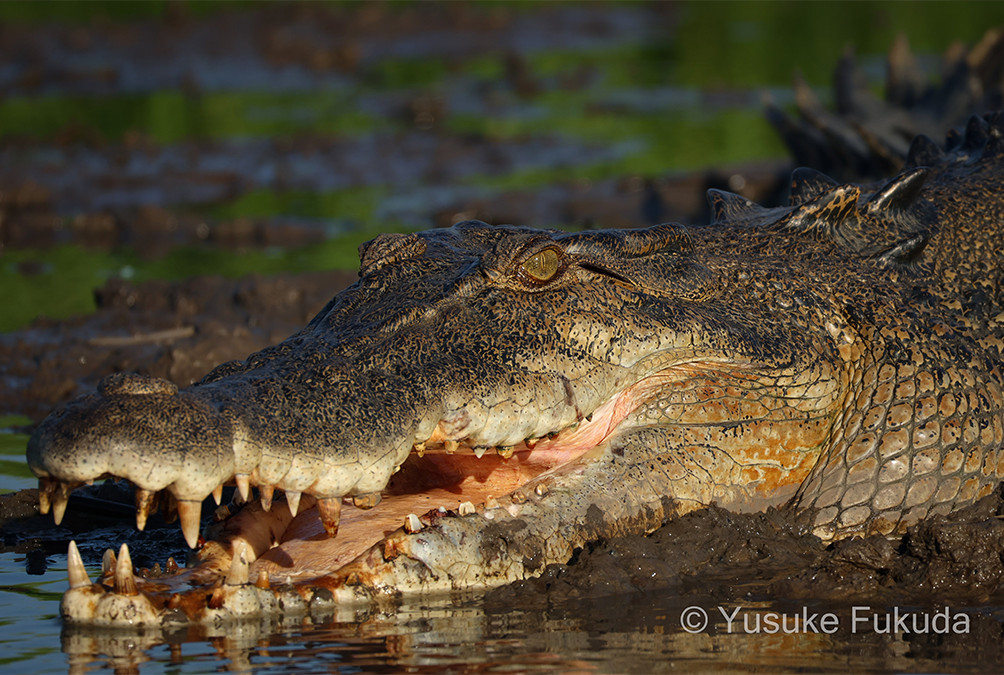
A croc’s life: below the surface, there’s more than meets the eye
Cover image: Yusuke Fukuda
Saltwater crocodiles are large predators that lurk in muddy waters, with jaws powerful enough to attack anything from water buffalo to humans... but they are also just big chilled-out lounge-lizards who love to sunbake.
These two things can be true at once, says researcher Yusuke Fukuda.
Fukuda has been fascinated by saltwater crocodiles ever since he saw a documentary about them at high school, back in his hometown of Tokyo. It sparked a passion that led him to the Northern Territory of Australia, where Fukuda has monitored saltwater crocodile populations for the past fifteen years.
Now he’s at the tail-end of a PhD in ecology and evolution with the ANU Research School of Biology looking into the movement patterns and genetic diversity of saltwater crocodiles. He explains what it’s like to work with the largest and oldest living reptile in the world.

“My job with the Northern Territory Government focuses on two main things. One is population monitoring. The other one is conflict between crocs and people,” he says.
Saltwater crocodiles are part and parcel of being in the Northern Territory. But there’s a real risk for people near waterways, especially as this once over-hunted species becomes more abundant with protection laws.
Fukuda spends a lot of time boating around the Darwin Harbour, Kakadu National Park, Mary River National Park and the traditionally-owned rivers of Arnhem Land monitoring populations and collecting data on the crocodiles. One method he uses to collect genetic information is to take a tiny tissue biopsy from their tail with a three-metre-long thin pole.
This happens under the darkness of night, from a boat that is often smaller and lighter than the crocodiles themselves. Shining a spotlight, Fukuda and his colleagues locate the crocs, steer the boat closer, and then jab the pole into the fatty tail tissue.
“I’ve got quite a few biopsy samples from crocs but surprisingly, none of them have become really angry at me. They always just jump up and then swim away,” he says.
“So, it’s not as dangerous as it looks.”
This is the chilled-out side of the crocs’ personality.
“They’re pretty peaceful sitting or floating on the water when you see them − you rarely see them attacking other animals,” he says. “We have so many fish here, like barramundi, so they aren’t hungry crocodiles.”
“You quite often see water birds like herons or magpie geese near them, even ducks walking right in front of a crocodile’s face. They don't care about each other.”

But don’t be fooled, saltwater crocodiles deserve healthy respect − and distance.
Crocodiles are known to attack people in Australia. While the famous statistic that MP Bob Katter once spouted of a north-Queenslander being “torn to pieces by a crocodile every three months” is an exaggeration, in most years there have been one or two fatal crocodile attacks in Queensland and the Northern Territory combined.
A spooky thing about saltwater crocodiles is that you can’t trust your senses that you’ll see or hear a croc: they are experts at hiding under the water’s surface.
“Water that is just two feet deep is enough for a four-metre crocodile to hide from you,” says Fukuda.
“Even if he's only two metres away from your feet, you won’t see him.”

Human-crocodile management is a tricky subject. Simply relocating captured crocodiles doesn’t work, Fukuda says.
“Now we know for sure, because crocodiles have a strong homing ability after being relocated,” he explains.
While it was known that saltwater crocodiles frequently swim back to their original location, Fukuda’s research showed that around 40% of the Northern Territory’s crocs are migrants, and some travelled more than 700 kilometres to get there.
He also discovered that one thing that will disrupt their strong homing ability is a geographic barrier, such as the Cobourg Peninsula with strong currents.
“So if a crocodile is near people, basically you have to remove it and put it in captivity, or it unfortunately has to be killed.”

But the ideal solution is public education, says Fukuda.
“We think that by raising awareness of the risks with both locals and visitors, you can reduce a good number of attacks effectively, especially in places like Australia.”
In other countries, such as Timor-Leste, Sri Lanka and Indonesia, the situation is more difficult.
“In Timor-Leste they say they lose more than 10 people every year to crocs,” he explains. “That’s really serious.”
On these islands, people often need to use waterways for washing, fishing, and their day-to-day livelihoods. So in those circumstances education is obviously not very useful or as effective. Other methods, like a caged area for human access to the river can save lives.

Despite the fact that crocodiles are usually just basking on the bank or taking a leisurely swim, sometimes you witness wild behaviours that will truly take your breath away, Fukuda says.
“I've only once seen two big males fighting each other. It was just before breeding time in the wet season.
“They growl with this deep voice and the water around them jumps because of the vibration.”
Fukuda says it’s an orchestrated kind of fight. Each croc waits for their turn to bite the other and push it under the water.
“It’s more like sumo wrestling,” he reckons.
“If they wanted, they could easily bite the other’s head off, but they don't do it.”
It’s just another reason Fukuda is fascinated by the saltwater crocs, as they continue to exert their composed, but powerful presence over the rivers of the Northern Territory.
Yusuke Fukuda is presenting his PhD Exit Seminar for the ANU Research School of Biology on Friday 20 October 2023, join us to find out more about his research.




